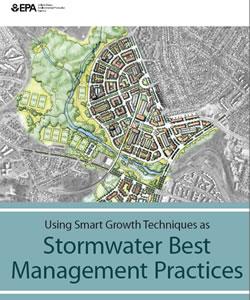
Communities across the country are adopting smart growth strategies to achieve environmental, community, and economic goals. Development strategies that use compact development forms, a mix of uses, better use of existing infrastructure, and preservation of critical environmental areas can protect water quality.
While the water quality and stormwater benefits of smart growth are widely acknowledged, there has been little explicit regulatory recognition of these benefits to date. Regulations under the National Pollutant Discharge Elimination System (NPDES) stormwater program offer a structure for considering the water quality benefits associated with smart growth techniques.
Compliance with federal, state, and local stormwater programs revolves around the use of “Best Management Practices,” or BMPs, to manage stormwater. Given the "built in" water benefits of smart growth at the site, neighborhood and watershed levels, smart growth techniques and policies are emerging as BMPs to manage stormwater runoff over the life of development and redevelopment projects.
Using Smart Growth Techniques as Stormwater Best Management Practices (2005) can help communities that have adopted smart growth policies and plans recognize the water benefits of those smart growth techniques and integrate those policies into stormwater planning and compliance. Taking credit for the work a community is already doing can be a low-cost and practical approach to meeting water quality goals and regulatory commitments. Examples of smart growth techniques and approaches covered in this publication include:
- Regional planning.
- Infill development.
- Redevelopment policies.
- Special development districts (e.g., transit oriented development and brownfields redevelopment).
- Tree and canopy programs.
- Parking policies to reduce the number of spaces needed or the footprint of the lot.
- "Fix It First" infrastructure policies.
- Smart growth street designs.
- Stormwater utilities.
Learn more about the National Pollutant Discharge Elimination System (NPDES) stormwater program.
Learn more about smart growth and water.
You may need a PDF reader to view some of the files on this page. See EPA’s About PDF page to learn more.- Stormwater Management Best Practices (PDF)(112 pp, 2 MB)
